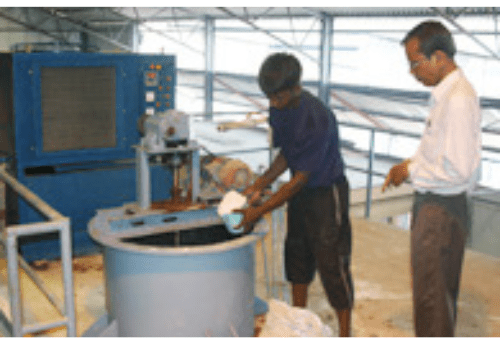Confectionery
Uses of Dewaxed Bleached Shellac in Food / Confectionery
Uses of Dewaxed Bleached Shellac in Food / Confectionery
The main uses of Dewaxed Bleached Shellac in food for the confectionery industry are for the coating chocolate goods, such as extruded chocolates, chocolate covered nuts and resins, and similar products.
The bleached shellac in food coating performs one or more of the following functions:
- enhances and protects the gloss
- serves as a barrier to moisture either entering or leaving the confection
- prevents blocking together
- extends shelf-life
Dewaxed Bleached Shellacs dissolved in a specially denature alcohol are the glazes employed for confectionery by the pan method. These glazes are also sometimes applied by brush or spray, as in the case of marzipans.
Solvents
Pure ethyl alcohol is the usual solvent for shellac in food for confectionery glazes. But each country has its own special regulations for the denaturing of alcohol, and isopropyl alcohol is also widely used. In the USA alcohol containing 35 percent of shellac is deemed to be denatured.
Formula for Chocolate Varnish
| Shellac | 50 grams |
| Sumatra benzoin | 150 grams |
| Vanillin | 1 gram |
| Alcohol | 800 grams |

Procedure of Shellac in food
The following procedure is suggested for finishing chocolate confections using shellac glaze.
While different manufacturers have their own methods. Some details which is available with us is as follows:
The coating operation should be carried out in conventional copper or stainless steel pans, and in Dust-free atmosphere.
Confectionery glaze contains 25 to 35 % of shellac in food. The choice of concentration is determined by the gloss desired; higher concentrations improve gloss.
In the glazing of pan-coated chocolates, a number of preglazing and glazing variables must be controlled carefully to ensure a uniformly high gloze.
The centres to be chocolate coated should first be smoothed out. Nuts sh0uld be sealed by applying one or two coats of a 50 percent gum arabic solution. To smooth the centre, a solution composed of 1/3rd gum arabic, 1/3 rd sugar syrup and 1/3rd glucose syrup may be applied. After the pieces have been wetted with the solution, they are dried off with a mixture of powdered sugar and cocoa.

The smoothed gummed-sugar centres are chocolate coated and allowed to stand overnight to set hard. The next day the confection is placed in a clean coating pan and wetted with a glossing syrup made of about 30-40% of glucose syrup and 60-70% of a 50% solution of gum arabic. The wet goods are allowed to tumble with cool air until they show signs of net sticking together. The pieces will then look Spotty and dull. Coor air is turned off and the material is allowed to tumble for about 20-30 Minutes until the right gloss is obtained and allowed to dry overnight before glazing.
The procedure may have to be repeated a few times to obtain proper gloss.
Glazing is done in a clean coating pan reserved for the purpose. The pan is charged with the material and just enough glaze is poured into the middle of the tumbling pieces in a very thin steam and mixed by hand. After the glaze has been added, the gloss will seem to disappear, then a current of cool air is turned on and the material allowed to tumble for about 25-30 minutes. The goods can be removed for packing.
To obtain the best results in confectionery glazing, the following hints are worth remembering:-
The material should not be glazed on the same day that it has been shinned with the glossing syrup. Overnight drying is necessary.
Before glazing the goods must have the desired gloss. On chocolate coated pieces, the glaze does not by itself provide the gloss but enhances and protects it.
The glazed goods should be tumbled in the pan until dry 20-30 minutes, but never over tumbled. There is a point of maximum gloss after which further panning with cause scuffing.
